Overview
The primary function of heavy duty trailer suspensions is to link the trailer to its wheels. This provides a compliant connection which protects the trailer cargo from the shock and vibration inputs developed at the road surface. In addition, the suspension must meet the customers’ expectations for usable life, and do so while being economical to manufacture. One of the challenges of trailer suspension design is that these requirements often conflict with each other. Trade-offs are often required in order to meet these performance requirements over the suspension’s entire operating range.
Challenge
A unique aspect of trailer suspension design is that regulatory authorities have designed specific tractor-trailer configurations that are required for legal use in areas under their jurisdiction. When designing a new suspension, engineers need to evaluate each of the different vehicle configurations where it will be applied. They also need to consider a wide range of operating conditions, such as making a tight turn or going over a railroad track. The goal is then to ensure that the suspension provides the right mix of performance and cargo protection for each combination of vehicle configuration and event. Engineers also need to understand what loads each of these scenarios will place on key components of the suspension. This knowledge allows these components to be designed to provide the promised service life, while also being as light as possible. By achieving these goals, the customer can minimize fuel costs, and the suspension manufacturer will minimize production costs.
In the past, this design process was accomplished by performing physical tests on tractors and trailers operating with specially instrumented prototypes of the new suspension. It required significant resources to set up and instrument a suspension system for just a single configuration. The testing process itself can also be time-consuming because of the need to deal with factors such as changing weather conditions, sensors that stop working, and wires that break. What can be seen in physical testing is limited by lighting, the position of the videographer, and components that may be hidden behind others. There is a limit on the number of sensors that can be used in a physical test, and some points are difficult or impossible to instrument. As a result, the design process can be long and expensive.
Solution
Dr. James Patterson, Principle Vehicle Systems Engineer for Hendrickson Commercial Vehicle Systems, now does much of this work using virtual Adams models. He imports the Creo CAD geometry of the suspension system into Adams, and completes the model by assigning rubber bushings, bump stop/rebound stops, airbags, shock absorbers, and other elements.
He attaches the suspensions to trailer models in the configurations used by customers. For example, the Safe, Production and Infrastructure-Friendly (SPIF) regulations issued by the Province of Ontario provide plans for 11 different tractor-trailer configurations that are legal on Ontario roads. The “SPIF4” combination includes five trailer axles, and consists of a Tridem suspension, three consecutive fixed axle suspensions with a common attachment to the trailer, and two independent steerable suspensions.
Dr. Patterson uses finite element analysis software to create flexible body models of the axle tube and trailing arm. Then he exports the modes of the flexible body model as a modal neutral file (MNF) that is incorporated into the Adams model. He has also modeled the test track road surfaces, which are set up to perform events that test the limits of the suspension performance, such as city turns, going over an obstacle, and reverse jack knifing. He has also created scripts that drive the tractor and trailer over these obstacles. These models typically run in less than five minutes.
Simulation provides a much better understanding of how the proposed suspension design performs than can be obtained by physical testing. The simulation animation can be easily panned, zoomed, or rotated to any view point and orientation. Various components of the vehicle can also be hidden from view in order to examine any aspect of the suspension motion. This allows Hendrickson engineers to study motion of the suspension that cannot be viewed during physical testing.
The Adams simulation determines the loads, accelerations, and displacements of every point in the model. The results help engineers intuitively understand how forces are transferred from the road, through the tire, into the suspension, and finally to the trailer. Hendrickson engineers use the loads calculated by the simulation to perform structural analysis. This allows the size and shape of the suspension components to be optimized, and also contributes to the development of the physical fatigue tests used to validate their reliability.
Dr. Patterson can easily change the axle spacing, or other aspects of the vehicle configuration, as well as change the event, such as making the corner sharper, in order to determine the impact these modifications have on the loads. For example, many of Hendrickson’s suspensions are lift-able. This means the air can be removed from the suspension airbags, which allows the wheels to be raised off the ground to disengage the suspension. Sometimes suspensions are disengaged under low load conditions, but there is also the possibility for an accidental disengagement. The model can easily be changed to determine the effects of lifting any suspension.
Dr. Patterson has on numerous occasions compared the tire loads, component forces, and suspension performance characteristics, such as ride height change, obtained with an Adams simulation to similar measurements obtained from physical testing, and found that they matched very closely.
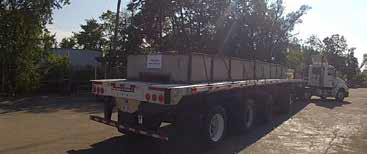
With physical testing it can be difficult to safely study suspension behavior
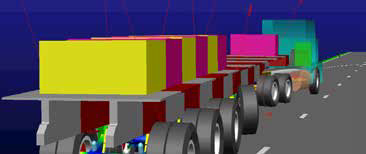
Simulation results make it possible to see every aspect of suspension behavior
Results/Benefits
“We can now simulate a new suspension, in a different trailer configuration, for a specific event, in a matter of hours as compared to the days or weeks that are required with physical testing,” Dr. Patterson said. “The fact that we can change the system much faster in the simulation than on an actual trailer makes it possible to evaluate the performance of our product in more configurations, all while spending less time and money building prototypes and performing physical testing. Of course, we always run a final physical test to ensure the accuracy of our simulations. The end result is that we are able to bring products to market faster, and generate larger revenues while reducing our product development expenses.”
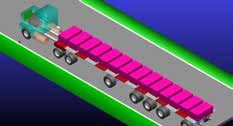
Adams model of SPIF4 configuation
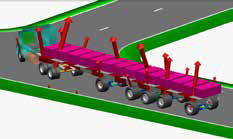
Adams simulation of SPIF4 configuration undergoing city turn event
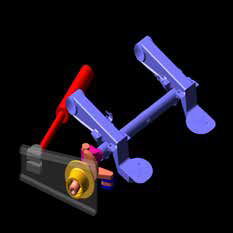
Loads determined by the simulation are used to design fatigue tests
About Hendrickson International
Hendrickson International, the parent of Hendrickson Trailer Commercial Vehicle Systems, is a leading global manufacturer and supplier of medium- and heavy-duty mechanical, elastomeric and air suspensions; integrated and non-integrated axle systems; auxiliary lift axle systems; parabolic and multi-leaf springs; and bumper and trim components to the global commercial transportation industry.





Leave A Reply